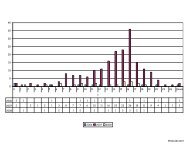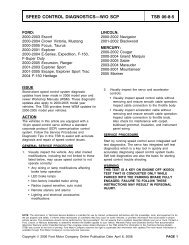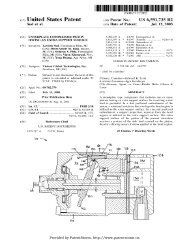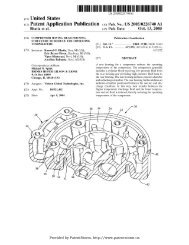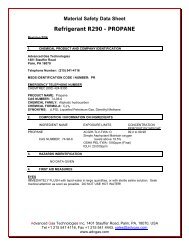Transpo Engineering Takes The Worry Out of Regulator ... - IDMsvcs
Transpo Engineering Takes The Worry Out of Regulator ... - IDMsvcs
Transpo Engineering Takes The Worry Out of Regulator ... - IDMsvcs
Create successful ePaper yourself
Turn your PDF publications into a flip-book with our unique Google optimized e-Paper software.
<strong>Transpo</strong>'s March 2004 - Rebuilders Forum..<br />
http://195.125.241.148/support/flyer/fl0304.htm<br />
Page 2 <strong>of</strong> 2<br />
• LI terminal, also known as feedback (FR). • RC terminal, also known as signal (SIG) •<br />
S .<br />
terminal, also known as B+ or sense (S, As). • No Lamp-Circuit function, Lamp is 100% controlled by the<br />
vehicle PCM. • <strong>Regulator</strong> Set Point range is 12.5 Volts to 16.0 Volts and is determined by the PCM signal.<br />
<strong>The</strong> PCM control signal that is sent to the regulator (via the vehicle PCM signal line) is a variable pulse-width<br />
modulated signal provided at a fixed 125 Hertz frequency. As an example, a 55% PWM signal from the PCM<br />
yields a regulation voltage <strong>of</strong> 14.25V (+/- 0.1)..<br />
Considering the intricacies <strong>of</strong> the design, and that full regulator function is dependent upon the vehicle<br />
computer interface, existing bench testing methods will no longer tell the full story.<br />
Without a custom test adapter with signal interface, only default voltage tests may be performed. A default<br />
voltage test will indicate that the regulator is basically functional but it will not answer the question <strong>of</strong> whether<br />
the regulator circuit will change the set point according to PCM commands, or whether feed-back from the<br />
regulator circuit is working or accurate .<br />
To load test an alternator using regulator default voltages, connect power-source B+ to the alternator output<br />
terminal as usual, then ground the regulator 'RC' pin (center-pin). Test voltage will read approximately 13.9<br />
Volts. Connecting power-source B+ to the 'S' pin in addition to grounding the 'RC' should yield a reading <strong>of</strong><br />
approximately 13.7 Volts. Alternator test output may be something less than the alternator's rated output, due<br />
to these lower voltages..<br />
It should be noted that the <strong>Transpo</strong> F601 design <strong>of</strong>fers an added 'efficiency' feature referred to as 'Burst<br />
Mode'. This function serves to maintain the voltage set point last directed by the PCM, rather than requiring<br />
continuous PCM adjustment to maintain the set point..<br />
Thank You For Your Business!



